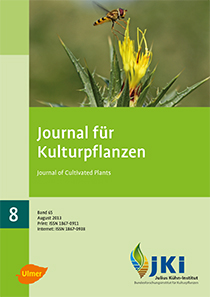Study on the influence of weather periods on the occurrence of leaf rust and powdery mildew in winter wheat using an interval-based correlation approach
DOI:
https://doi.org/10.5073/JfK.2013.08.03Keywords:
Puccinia triticina, Blumeria graminis f. sp. tritici, weather, climate, correlation analysisAbstract
Leaf rust (Puccinia triticina) and powdery mildew (Blumeria graminis f. sp. tritici) are among the most important diseases on winter wheat in Germany. The influence of weather periods on both diseases is little understood. Data on leaf rust and powdery mildew severity from 1976 to 2010 at different sites in the state of Saxony-Anhalt were used in the present study. The “window pane” algorithm was used to analyze and compare the disease-weather relationships for both pathogens. Over 300,000 possible relationships between climate variables and disease occurrence were analyzed using this approach. The results were displayed as correlograms to gain profound insight into disease-weather relationships and their temporal variability during the epidemic year. Our analysis of the influence of temperature, precipitation sums, radiation and further climatic variables on leaf rust and powdery mildew infestation on winter wheat showed numerous significantly positive and negative effects on the occurrence of both diseases. The occurrence of P. triticina showed positive relationships with mean daily temperatures during spring, winter and autumn. There were significant negative correlations between B. graminis occurrence and mean sunshine duration per day from the beginning of the year until anthesis. Finally, our findings are compared to those in the literature, and new perceptions are discussed.
Published
Issue
Section
License
The content of the journal is licensed under the Creative Commons Attribution 4.0 License. Any user is free to share and adapt (remix, transform, build upon) the content as long as the original publication is attributed (authors, title, year, journal, issue, pages).
The copyright of the published work remains with the authors. The authors grant the Journal of Cultivated Plants, the Julius Kühn-Institut and the OpenAgrar repository the non-exclusive right to distribute and exploit the work.







